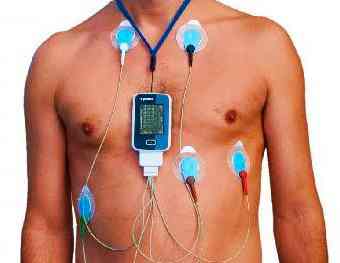Holter Monitoring
What is a Holter monitor?
What is Holter monitor? – by Dr. Kedar Kulkarni.
Holter monitor is a small, battery-powered medical device that measures your heart’s activity, such as rate and rhythm. Your doctor may ask you to use one if they need more information about how your heart functions than a routine electrocardiogram (EKG) can give them.
Twenty-four-hour Holter monitoring is a continuous test to record your heart’s rate and rhythm for 24 hours. You wear the Holter monitor for 12 to 48 hours as you go about your normal daily routine. This device has electrodes and electrical leads exactly like a regular EKG, but it has fewer leads. It can pick up not only your heart’s rate and rhythm but also when you feel chest pains or exhibit symptoms of an irregular heartbeat or arrhythmia.

How it works
The Holter monitor is small. It’s slightly larger than a deck of playing cards. Several leads, or wires, are attached to the monitor. The leads connect to electrodes that are placed on the skin of your chest with a glue-like gel. The metal electrodes conduct your heart’s activity through the wires and into the Holter monitor, where it’s recorded.
You wear a small pouch around your neck that holds the monitor itself. It’s important to keep the monitor close to your body during the testing period to make sure the readings are accurate. Your doctor will show you how to reattach electrodes if they become loose or fall off during the testing period.
You’ll get instructions that explain how to take care of your monitor and what not to do while you’re wearing it. It’s important to avoid bathing, showering, and swimming while you’re wearing the monitor.
You’re encouraged to participate in your normal activities during the 24-hour Holter test. You’ll be directed to record your activities in a notebook. This helps your doctor determine if changes in heart activity are related to your behaviors and movements.
Wearing the Holter monitor itself has no risks involved. However, the tape or adhesives that attach the electrodes to your skin can cause mild skin irritation in some people. Make sure to tell the technician that attaches your monitor if you’re allergic to any tapes or adhesives
A 24-hour Holter monitor test is painless. However, be sure to record any chest pain, rapid heartbeat, or other cardiac symptoms you have during the testing period.
Understanding the results
After the recommended testing time frame has passed, you’ll return to your doctor’s office to have the Holter monitor removed. Your doctor will read your activity journal and analyze the results of the monitor. Depending on the results of the test, you may need to undergo further testing before a diagnosis is made.
The Holter monitor may reveal that your medicine isn’t working or your dosage needs to be altered if you’re already taking medication for abnormal heart rhythm. It’s especially useful in detecting abnormal heart rhythms that are painless and unknown to you.
Wearing a Holter monitor is painless and one of the best ways to identify potential heart problems or other issues.
